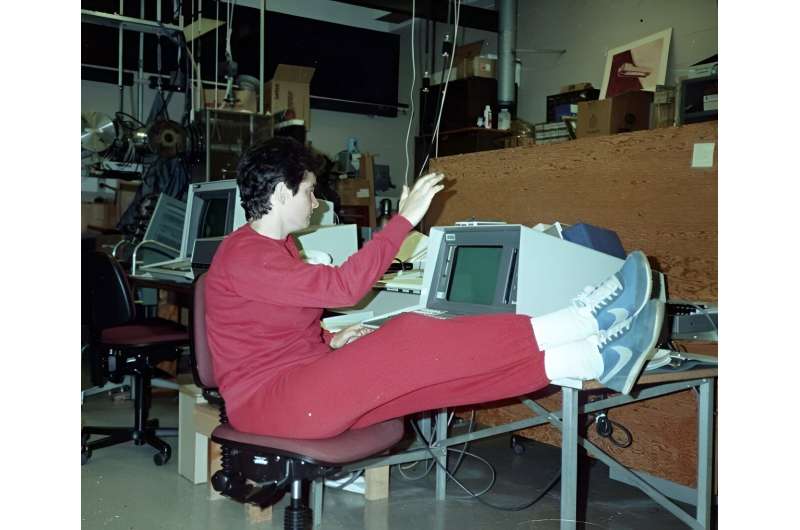This article has been reviewed according to Science X's editorial process and policies. Editors have highlighted the following attributes while ensuring the content's credibility:
fact-checked
trusted source
proofread
As Voyager 1's mission draws to a close, one planetary scientist reflects on its legacy

For nearly 50 years, NASA's Voyager 1 mission has competed for the title of deep space's little engine that could. Launched in 1977 along with its twin, Voyager 2, the spacecraft is now soaring more than 15 billion miles from Earth.
On their journeys through the solar system, the Voyager spacecraft beamed startling images back to Earth—of Jupiter and Saturn, then Uranus and Neptune and their moons. Voyager 1's most famous shot may be what famed astronomer Carl Sagan called the "pale blue dot," a lonely image of Earth taken from 6 billion miles away in 1990.
But Voyager 1's trek could now be drawing to a close. Since December, the spacecraft--which weighs less than most cars--has been sending nonsensical messages back to Earth, and engineers are struggling to fix the problem. Voyager 2 remains operational.
Fran Bagenal is a planetary scientist at the Laboratory for Atmospheric and Space Physics (LASP) at CU Boulder. She started working on the Voyager mission during a summer student job in the late 1970s and has followed the two spacecraft closely since.
To celebrate Voyager 1, Bagenal reflects on the mission's legacy—and which planet she wants to visit again.
Many are impressed that the spacecraft has kept going for this long. Do you agree?
Voyager 1's computer was put together in the 1970s, and there are very few people around who still use those computing languages. The communication rate is 40 bits per second. Not megabits. Not kilobits. Forty bits per second. Moreover, the round-trip communication time is 45 hours. It's amazing that they're still communicating with it at all.
What was it like working on Voyager during the mission's early days?
At the very beginning, we used computer punch cards. The data was on magnetic tapes, and we would print out line-plots on reels of paper. It was very primitive.
But planet by planet, with each flyby, the technology got a lot more sophisticated. By the time we got to Neptune in 1989, we were doing our science on much more efficient computers, and NASA presented its results live across the globe over an early version of the internet.
Think about it—going from punch cards to the internet in 12 years.
How did the Voyager spacecraft shape our understanding of the solar system?
First of all, the pictures were jaw-dropping. They were the first high-quality, close-up pictures of the four gas giant planets and their moons. The Voyagers really revolutionized our thinking by going from one planet to the other and comparing them.
Jupiter and Saturn's ammonia white and orange clouds, for example, were violently swept around by strong winds, while Uranus and Neptune's milder weather systems were hidden and colored blue by atmospheric methane. But the most dramatic discoveries were the multiple distinct worlds of the different moons, from Jupiter's cratered Callisto and volcanic Io to Saturn's cloudy Titan to plumes erupting on Triton, a moon of Neptune.
The Jupiter and Saturn systems have since been explored in greater detail by orbiting missions—Galileo and Juno at Jupiter, Cassini at Saturn.

Voyager 2 is the only spacecraft that has visited Uranus and Neptune. Do we need to return?
My vote is to return to Uranus—the only planet in our solar system that's tipped on its side.
We didn't know before Voyager whether Uranus had a magnetic field. When we arrived, we found that Uranus has a magnetic field that's severely tilted with respect to the planet's rotation. That's a weird magnetic field.
Jupiter, Saturn and Neptune all emit a lot of heat from the inside. They glow in the infrared, emitting two and a half times more energy than they receive from the sun. These things are hot.
Uranus isn't the same. It doesn't have this internal heat source. So maybe, just maybe, at the end of the formation of the solar system billions of years ago, some big object hit Uranus, tipped it on its side, stirred it up and dissipated the heat. Perhaps, this led to an irregular magnetic field.
These are the sorts of questions that were raised by Voyager 30 years ago. Now we need to go back.
Culturally, Voyager 1's most lasting impact may be the 'pale blue dot.' Why?
I have huge respect for Carl Sagan. I met him when I was 16, a high school student in England, and I shook his hand.
He pointed to the Voyager image and said, "Here we are. We're leaving the solar system. We're looking back, and there's this pale blue dot. That's us. It's all our friends. It's all our relatives. It's where we live and die."
This was the time we were just beginning to say, "Wait a minute. What are we doing to our planet Earth?" He was awakening or reinforcing this need to think about what humans are doing to Earth. It also evoked why we need to go exploring space: to think about where we are and how we fit into the solar system.
How are you feeling now that Voyager 1's mission may be coming to an end?
It's amazing. No one thought they would go this far. But with just a few instruments working, how much longer can we keep going? I think it will soon be time to say, "Right, jolly good. Extraordinary job. Well done."
Provided by University of Colorado at Boulder





















